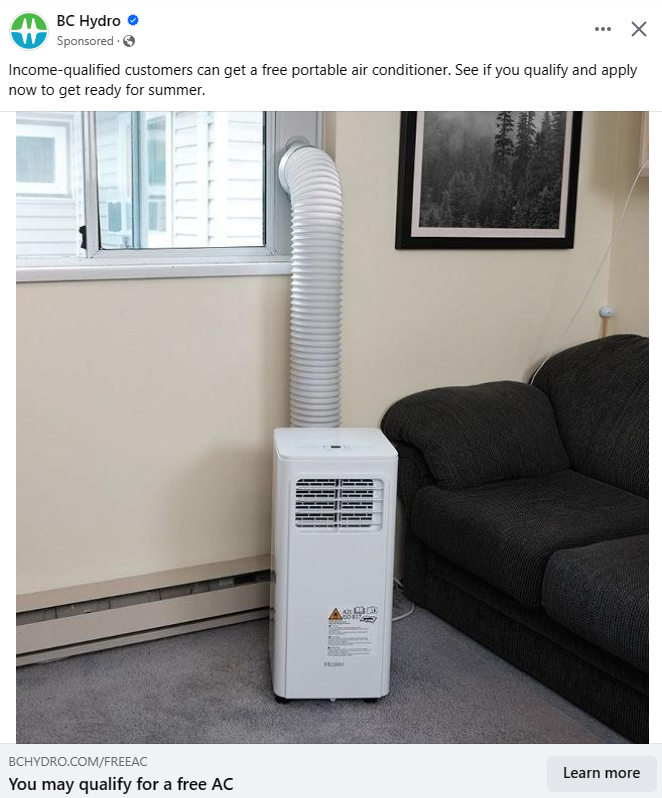You may have seen BC Hydro ads on social media recently offering free portable air conditioning units.
If you meet the definition of a low-income household (earning less than $60,800 for a 3-person household, for example), or have a letter of recommendation from your regional health authority, BC Hydro will buy you a portable air conditioning unit (FortisBC has a similar program for its customers).
The free air conditioners are offered as part of BC Hydro’s Energy Conservation Assistance Program, which is ironic because additional air conditioners do the exact opposite of conserving electricity. But presumably there are efficiencies to be gained from BC Hydro handling the requests, which it does for other low-income programs that actually will conserve electricity, rather than creating a new government agency to do that.
The BC government announced the $10 million program in June 2023, stating that BC Hydro expects to install 8,000 units over three years. The program is intended to protect “people who are medically vulnerable and have low incomes” from the effects of extreme heat.
So, who’s paying for this? BC taxpayers.
Which begs the follow-up question: why taxpayers and not BC Hydro ratepayers?
Role of the economic regulator
One of the perennial issues in utility regulation is ensuring that ratepayers are only charged the costs necessary for the utility to provide safe and reliable service. The BCUC examines the proposed costs of utilities to ensure that ratepayers are not being charged for something they should not pay for.
This issue applies to all utilities, but there is an additional challenge when regulating a government-owned utility, such as BC Hydro. The government might want BC Hydro to pay for its social programs; given that it owns the utility and appoints its board of directors, it probably has enough influence over the utility to try it on.
The BCUC could, and probably should, disallow social program costs if BC Hydro were to propose recovering them in rates. Policies such as free air-conditioning units for low-income households might be good public policy, but the cost is not necessary for BC Hydro to provide safe and reliable electricity service. In fact, with a shortage of electricity looming, it could be argued that encouraging more air conditioning use is actually detrimental to providing safe and reliable service.
By providing funding for the program from taxpayers’ pockets, the government has avoided a dilemma for the BCUC, and the possible embarrassment of the funding being denied.
Fairness and discrimination
Using ratepayers’ money for funding public policy has another problem too. If BC Hydro were to pay for the free air-conditioning units with ratepayers’ funds, it would mean that all ratepayers would be paying for it in their electricity rates, regardless of their income. Lower income households would also see their bills rise, possibly to pay for the air conditioners of others who earn more. This does not appear to be either fair or good public policy, and the BCUC might question whether this is undue discrimination in rates.
Paying for this program using taxpayers’ rather than ratepayers’ money is fairer, in the sense that more of the funding comes proportionately from wealthier people. The BC government received $49 billion in taxation revenue in 2022/23, of which $17.3 billion (35 percent) came from personal income tax. Since personal income tax is progressive (if you earn more, you pay a higher proportionately of your income in tax), this means that wealthier people are paying proportionately more for the free air conditioning units.
And another thing
Since the government is concerned about the effect of extreme heat on low-income households, it might want to take a look at the provincial building codes. The new housing development under construction at Oakridge, in south Vancouver, includes 14 towers with 2,600 homes for residents. The BCUC recently approved an application for a thermal energy system for the development, providing heat to suites in 14 towers but air conditioning to only 13. The missing tower? Building 2, which according to the evidence contains the affordable housing units, has “no cooling provided to the residential suites.”


